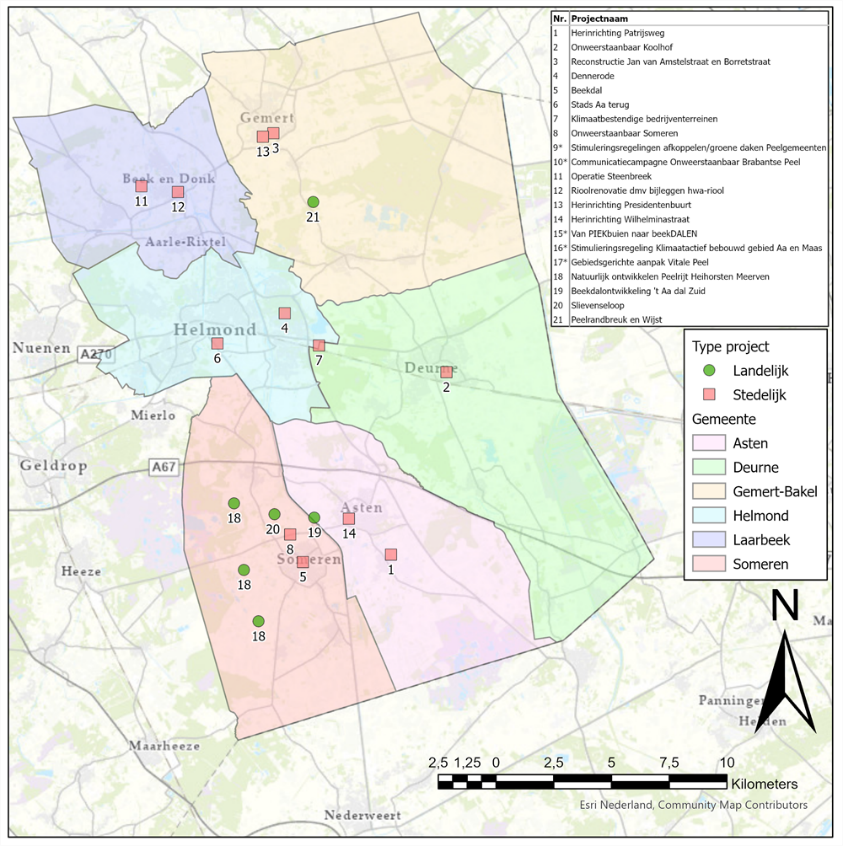Implementation agenda featuring 21 projects in Brabantse Peel region
In the Brabantse Peel region, the changing climate is also entailing risks in terms of habitability, health, nature, and the economy. The municipalities in this area intend to reduce the impact of the increasing heat, drought, and waterlogging by implementing measures in public and private spaces. To provide a picture of the intended climate-proofing efforts, they have drawn up a climate adaptation implementation agenda in collaboration with the Aa en Maas district water board and the Brabant Water drinking water company.
How has the implementation agenda been developed?
The municipalities of Asten, Deurne, Gemert-Bakel, Helmond, Laarbeek, and Someren are located in the Brabantse Peel working region, one of the working regions set out in the Delta Plan on Spatial Adaptation. In 2019, these municipalities conducted stress tests. The reports and the maps pertaining to several of the stress tests are available via the Map of Examples at the Brabant Climate Portal. Based on this information and risk dialogues, the Peel municipalities, the Aa en Maas district water board, and the Brabant Water drinking water company have identified more than one hundred projects. Out of this number, they have selected 21 projects that would be interesting to follow; these are highlighted in the implementation agenda. Some have been selected because the partners are proud of these projects, others because the partners are interested in the developments. Yet other projects are being carried out under the Elevated Sandy Soils Delta Programme or are funded by the central government under the Climate Adaptation Incentive Scheme.
What does the implementation agenda involve?
The “Irresistible Brabantse Peel” implementation agenda (PDF, 12 MB) comprises a selection of 21 projects being carried out between 2021 and 2027 in the purview of climate-proofing the Brabantse Peel region. The implementation agenda first outlines national and regional climate adaptation policies. Subsequently, it sets out the ambitions of the partners and their collaboration structures: The Effective Water Management working unit and the Inter-municipal Coordination Consultation Body. It concludes with the actual implementation programme, comprising a description of the projects.
What do the parties intend to achieve?
The projects on the regional implementation agenda will help to combat waterlogging and dehydration. The greening projects will additionally help to combat heat stress. The partners intend to gradually develop their strategies into an integrated approach. In the Peel municipalities, climate adaptation currently mainly involves a combination of local projects. In the years ahead, the partners intend to tackle the projects on a more regional scale and in an interconnected manner. Furthermore, current climate adaptation efforts are mainly focused on water issues. The partners seek to expand climate adaptation to the spatial and social domains. In addition to government bodies, they also intend to provide action perspectives for residents, entrepreneurs, and other stakeholders.
Examples of actions and measures
For each project, the implementation agenda specifies the party responsible, the timeframe, and how it is carried out. The figure below shows the 21 selected projects. The majority of the projects pertain to urban areas; the remaining projects involve rural areas. Most of the projects are linked to a specific location and are represented by a number on the map. However, some projects involve the entire or part of the Brabantse Peel region; these numbers are marked with an asterisk in the legend and are not represented on the map.

How are the results being monitored?
New insights and developments may dictate reconsideration of the projects on the implementation agenda. The partners have developed a dashboard to monitor progress. At the semi-annual steering group meetings of the Effective Water Management working unit, the progress being made in the projects is discussed on the basis of this dashboard. In addition, new stress tests are conducted every six years or earlier if developments so require. These stress tests can demonstrate whether the measures implemented have produced the desired effect and can identify any existing or new bottlenecks that require additional attention.
Lessons to be learned
It would be a waste of time and energy to start out by aiming for large, integrated projects covering an entire Delta Plan working region. First of all, the goal is to achieve momentum and collaboration. Carrying out interesting and inspiring projects, either collectively or individually, will bring about connection, trust, satisfaction, and pride. This will provide a good basis for collaborating on larger, integrated projects.
Contact person
Meggie Spierings
Secretariaat werkeenheid Doelmatig waterbeheer Brabantse Peel
meggie.spierings@gemert-bakel.nl
